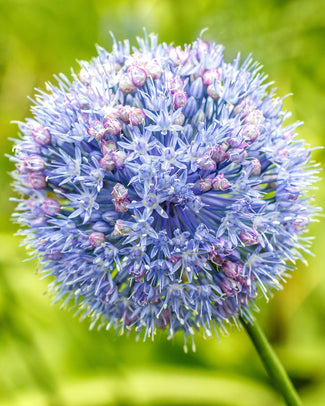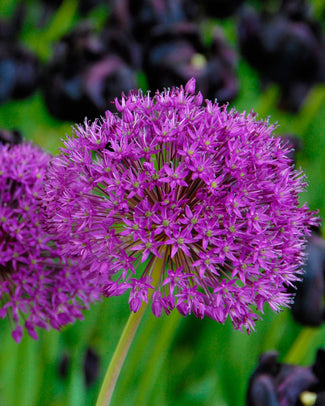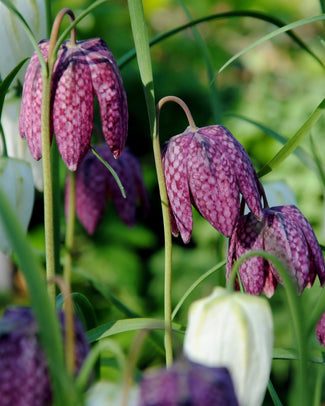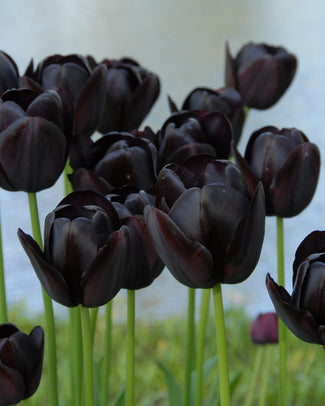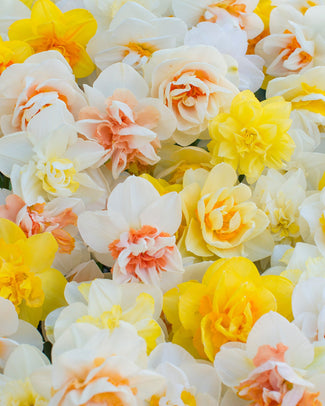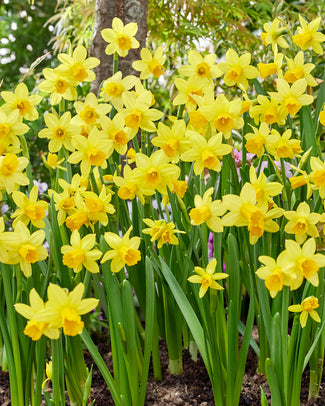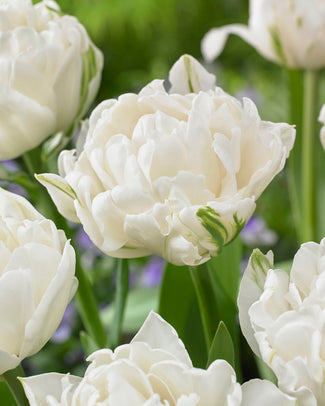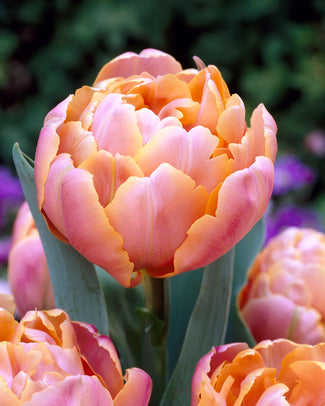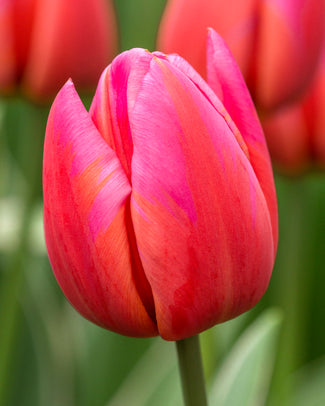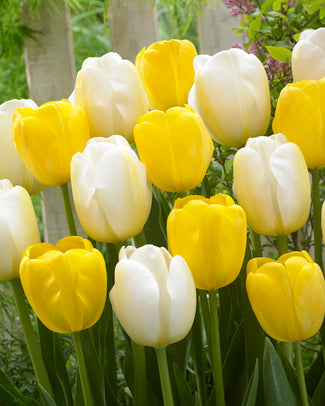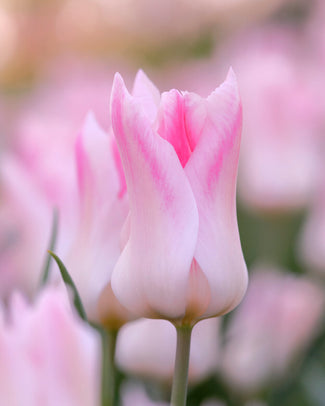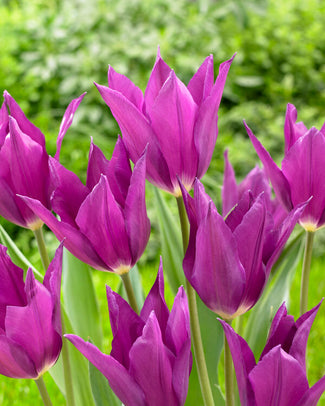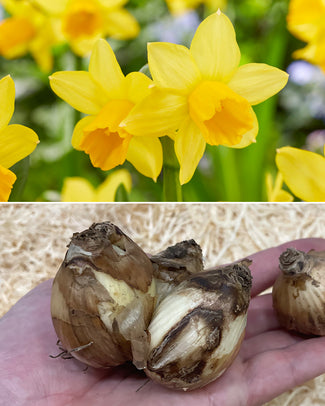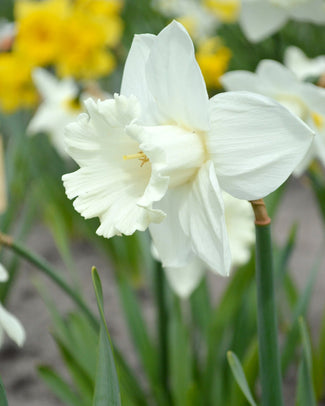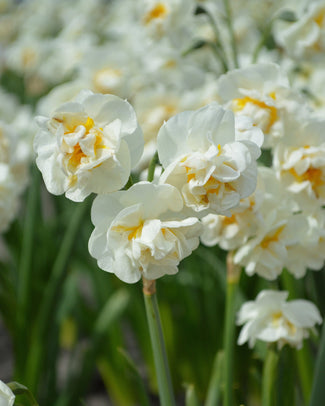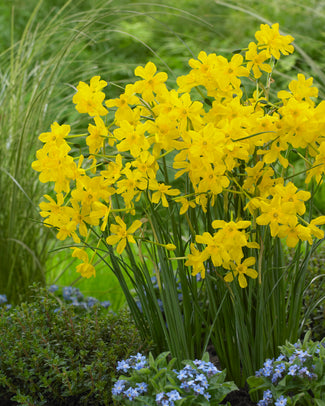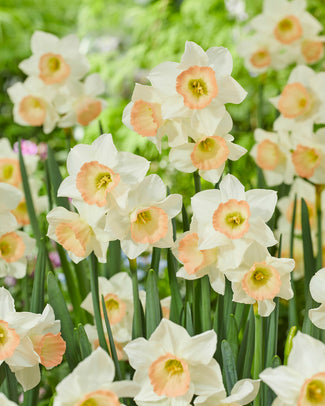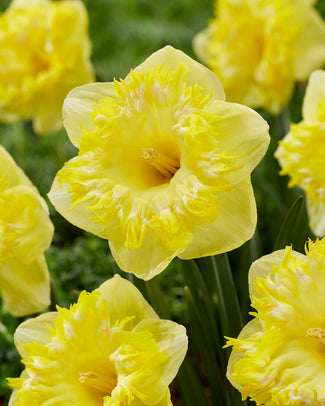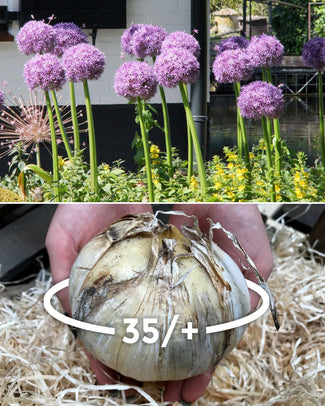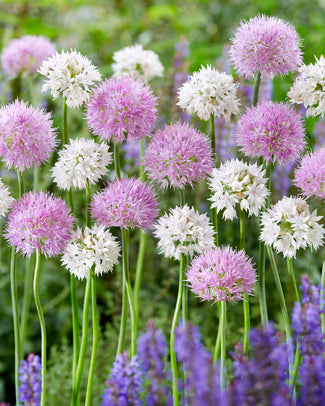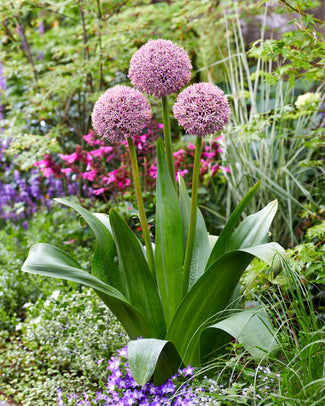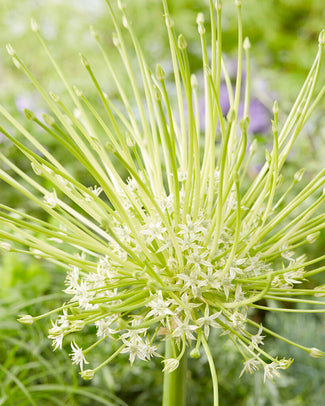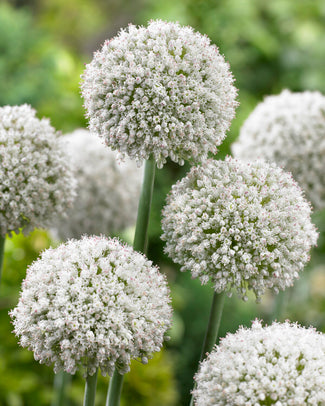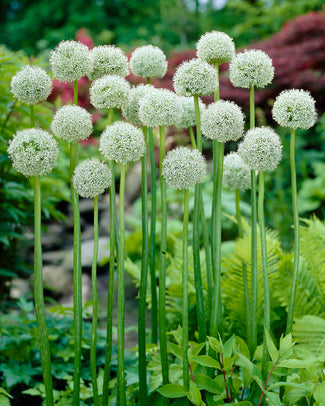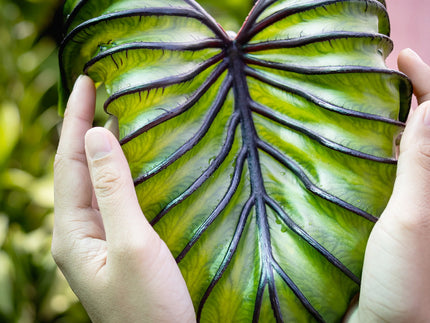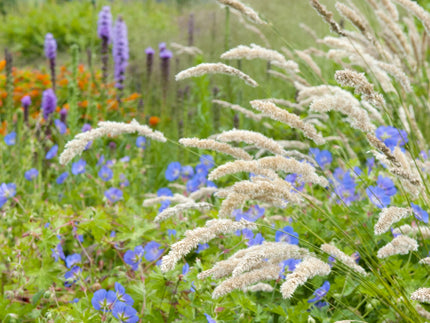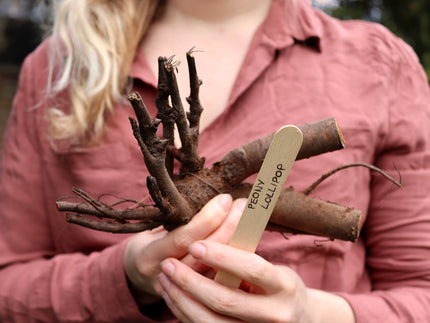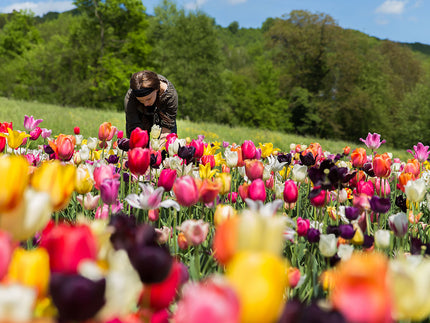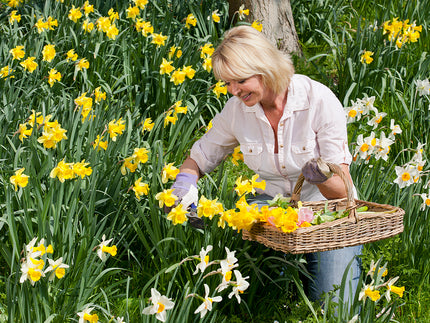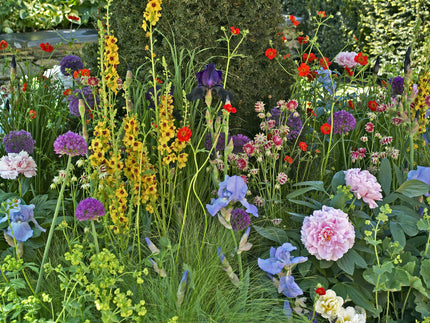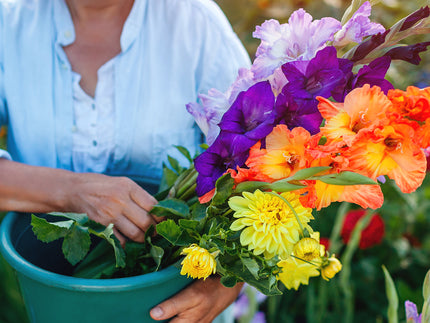
101 questions about flower bulbs (and, of course, the answers)
Do you have any questions about spring bulbs? You may be wondering how often your spring bulbs need to be watered, how many flowers you can expect per bulb, how many you'll need or whether they grow back every year. You're not alone! You'll find the answers to these frequently asked questions, and more, below.

Flower bulbs general FAQ
Spring flowering bulbs should be planted between September and December—they need several weeks in the soil in cool conditions in order to flower during spring. Flower bulbs should always be planted in the season that they are supplied to you and will not store until the following year.
As a general rule, bulbs like to be planted at a depth that is 2-3 times the height of the bulb. There are some exceptions—you can check the recommended planting depth for specific varieties in our detailed planting and care instructions.
Potted bulbs need to be in a growing medium which is kept moist, but well-drained. Ideally pots should have adequate drainage holes so that water and flow through and not accumulate. If growing bulbs under cover or indoors in pots with no drainage holes, take care to water sparingly and only when the soil starts to feel dry.
Bulbs should be planted the correct way up to ensure the best growth, but if a bulb is planted on its side it will often grow normally. Bulbs planted upside down, may still manage to grow but will generally not survive long as this causes considerable stress. If you think you have planted your bulbs upside down, they should be lifted and replanted correctly at the earliest opportunity, preferably whilst they are still dormant.
Bulbs must be planted within the same season they are supplied and cannot be stored until the next year. Flower bulbs must complete a growth cycle every year in order to survive and they will naturally start to deteriorate and become unviable over time if not planted while fresh. It is better to plant them late if the bulbs still appear healthy and firm, rather than store for any longer.
Bulbs which flower every year are known as perennial bulbs. Popular perennial bulbs include narcissi, crocus, alliums and muscari. You can view only perennial spring bulbs by selecting 'perennial' from the search filter or by clicking here.
There is a huge range of flowers which grow from bulbs—tulips, narcissi, alliums, crocus and fritillaria are just a few examples. You can view our full range of spring flowering bulbs here.
Most spring bulbs should be planted in autumn and there is no need to soak them in water first—just plant them straight outside in pots or borders. However, some bulbs which start to grow in autumn/winter, particularly anemones and ranunculus, do appreciate a soak in water for a few hours prior to planting. You can check whether specific varieties need soaking before planting in our detailed planting and care instructions.
Some flower bulbs multiply, whereas some other bulbs are grown as annuals, for first-year impact only. Bulbs which multiply over time and gradually spread are known as naturalising bulbs. You can view our full range of naturalising bulbs here.
Most perennial spring bulbs should remain in the ground all year round. Perennial varieties will return year after year where they were originally planted. You can also relocate them while they’re dormant, either in late spring or early autumn.
The ideal planting window for spring-flowering bulbs is between September and December. After this point, they naturally start to deteriorate if unplanted. If you haven’t planted your bulbs within this ideal planting window, it’s still worth planting them provided they are still firm and appear healthy. When planted very late, they may only flower lightly or produce a foliage-only display in their first year. The bulbs will not store and remain viable until the following year.
Most spring bulbs remain dormant through winter and sprout from early spring onwards. Some varieties may not start to sprout until later in the spring when the weather is warmer. Bulbs planted in early autumn may start to sprout leaves before becoming dormant for winter.
Bulbs like to be in a growing medium which is kept moist, but well-drained. If pots are under cover, or if there is very little rain through the winter and early spring, then they will need watering. You can check to see if they need watering by gently tipping the pot—if it feels light, they are dry and need some water. Likewise, if the soil feels dry 5-10cm below the surface. Take care not to over-water however—the bottom of the pot should have adequate drainage holes and while the bulbs are still dormant, they can be allowed to dry out before watering again.
Spring bulbs should be planted between September and December whether they are in pots or borders. From around December onwards, spring bulbs will naturally start to deteriorate and become less viable if unplanted. If it is passed this ideal planting window, it is still worth planting the bulbs late, providing the bulbs appear firm and healthy. They will not store until the following year.
Generally speaking, bulbs should be planted at a spacing of at least 2-3 times the width of the bulb. You can refer to our handy Bulbs per m2 guide for a rough idea of how many you'll need to fill a space.
You can either leave bulbs planted where they are, or you can lift them once they have fully died back and store them in a cool, dry place over summer and replant them the following autumn. After they have finished flowering, it is a good idea to snip off the seedhead but to leave the stem and leaves to die back fully before you remove them—this will help replenish the bulb for future years. If you have bulbs growing in pots which you want to use for something else, you can transfer them directly into another part of the garden once they have finished flowering. You can transfer them while they are still green, taking care not to damage the roots—and let them die back in their new position.
Flower bulbs planted too deep may flower later than expected and may also produce more foliage than flowers as they will have exerted most of their stored energy to reach the surface and will therefore produce foliage at the expense of flowers to replenish the bulb.
You can plant different varieties together to create a combination. This works well providing all varieties enjoy the same growing conditions and aspect. You can layer bulbs in a large pot for an extended period of interest—you can see an example of this planting method in our video: Bulb Lasagne! How to plant a layered pot of spring bulbs
Bulbs look great planted with complimentary bedding such as viola and pansy. You can also plant layers of smaller bulbs above larger bulbs in a bulb lasagne. Choosing varieties which flower at different times maintain a longer period of interest. Remember that the bedding will also demand nutrition from your compost when using pots and hanging baskets so a feeding regime would be recommended to ensure your bulbs and plants thrive.
For most spring bulbs, one bulb will produce one flower stem or one cluster of stems. The amount of flowers produced on the stem depends on the variety in question. Some bulb types may produce one stem with multiple blooms, others produce one large bloom at the top of one stem. Some bulb types, such as crocuses, produce a few flowers per bulb depending on the size of the bulb. Tulips and daffodils typically produce one flower stem per bulb.
In a mixed container, plant taller varieties in the centre with shorter varieties around the outside. In borders, plant the tallest varieties in groups or drifts at the back of the border, and shorter varieties in groups or swathes towards the front of the border. Flowers can make a bigger impact when planted in groups which are repeated around the garden. Bulbs should be planted according to their required spacing as recommended in the plant profile. This can be in a circular fashion in your pot, in rows or groups in your borders or in a more random fashion to create a natural or meadow style.
You can dig a hole for each individual bulb, or if you have a lot to plant, you can dig wider hole or trenches and plant multiple bulbs at a time. Just ensure they are planted at the correct spacing.
Bulbs are most often very determined to grow and can still perform if planted late, however if planting very late you may find that some bulbs have started to naturally deteriorate and need to be discarded. You may also experience some bulbs appearing blind or with inferior quality blooms. This is because the bulbs have not been exposed to a long enough cold period, have not had time to develop roots and not enough time to develop shoots and flowers. Bulbs cannot be stored until the following year. If they appear in good health, it is worth planting them late to give them their chance to grow.
Most bulbs should be planted 2-3 times their own height. Bulbs that are too shallow can often fail to perform as the bulb does not have sufficient distance from the top of the bulb to the surface of the soil to support the above ground parts of the flower. Nutrient uptake can be restricted as the roots are not deep enough in the soil and they may be prone to drought as the top 10cm of the soil tends to be dry.
You can plant bulbs in wet, but not waterlogged, soil. Flower bulbs grow best in well drained soils, it is not recommended for the majority of bulbs that they are planted soils which remain very wet or waterlogged over winter as this can cause them to deteriorate and rot.
There’s no need to add anything to a good quality multipurpose compost when planting spring bulbs. If you are planting directly into beds and borders where the soil is heavy clay or very dry and sandy, you may like to dig in some well-rotted leaf mold, garden compost or manure to help improve the soil structure and fertility.
Usually, spring bulbs have a pointed end and rounded end, but it is not always the case. Bulbs should be planted with the pointed tip or any obvious growing points facing upwards. If it is unclear which way to plant your bulbs, corms, rhizomes or tubers, you can find specific planting details in our online growing instructions.
Spring bulbs can be planted directly into free draining topsoil or compost. If you prefer to grow them in patio pots and containers always use fresh, good quality multipurpose compost.
Bulbs generally need to be planted at a depth that is 2-3 times the height of the bulb. There are some exceptions, you can check the recommended planting depth for specific varieties in our detailed planting and care instructions. If planting in pots, ensure that there’s a good layer of compost between the bulb and the bottom of the pot, so it can establish its roots. This layer should be at least 3-4 times the height of the bulb.
Spring flowering bulbs don’t normally require any feed to produce reliable, healthy growth and blooms. However, they will benefit from a feed while in growth, especially when growing in a pot. You can mix a general slow-release fertiliser or an organic fertiliser such as Blood, Fish and Bone to the surrounding soil or potting compost. Alternatively, you can apply a general purpose liquid feed fortnightly when the bulbs are in growth. There is no need to feed bulbs when they are dormant.
Buying bulbs online is quick and easy, with a wide range of different varieties to choose from. Browse our website from the comfort of your own armchair and look forward to your top-quality bulbs being delivered directly to your door!
Hardy spring bulbs can be left in the ground all year round and many species will start to naturalise after a few years. After flowering, allow the foliage to die back naturally. Once it has turned completely yellow, the old foliage and stems can be trimmed away. Bulbs which are not fully hardy should be lifted and stored in cool, dry and frost free conditions. If grown in pots there is no need to lift them – simply move the pot to a frost-free location until all risk of frost has passed.
It is not usually necessary to water spring bulbs after planting because they will remain dormant for a while, and do not require a lot of moisture to start with. Rainfall during autumn and winter usually provides sufficient moisture for spring flowering bulbs. Once they start to grow in spring, they may need additional water during prolonged dry spells. Some varieties, such as Ranunculus and Anemones, start to sprout in autumn/winter and they may need watering if the soil becomes very dry.
Spring bulbs, on the whole, are very easy and reliable to grow. Tulips, Narcissus, Hyacinths, Muscari and Alliums are among the easiest of spring bulbs to grow and a good place to start with if you’re a beginner. Follow the instructions in our planting guide and you should achieve fantastic results.
Spring bulbs naturally flower during spring, some varieties earlier in the season than others. The bulbs are planted whilst dormant in autumn and they usually remain dormant over winter. Depending on which varieties you choose, you can expect to see growth appearing between winter and mid spring.
Some varieties, such as alliums, tulips and hyacinths, typically produce one flower stem per bulb, however the number of flowers per stem varies depending on which varieties you choose. Our large-sized bulbs often produce multiple stems on some varieties, such as amaryllis and narcissus. Bare root plants, such as peonies, usually produce multiple stems and multiple flowers per plant.
It is necessary to replace the soil in containers for each growing season. When in pots, bulbs grow best in fresh compost. This means that you should remove your bulbs from pots once they have died back after first growing season and either replace the compost before replanting them, or get new bulbs for the pots and plant the old bulbs out into the garden.
Most of the varieties in our spring bulb range will flower in the first year. Some perennial varieties, such as peonies, may take another year or so to settle in before they will flower.
Trending now
View allTulips FAQ
Tulip bulbs must be planted in autumn, the same year that they are supplied. It is best to plant them when soil temperatures are cooler, so avoid planting them early in the season while the weather is still warm and get them planted between mid-October and December for best results.
Darwin hybrid and botanical tulips are perennial and last for years, returning every spring. However, most other tulip varieties produce their optimum flowers in the first year and then will not return reliably from the second year onwards.
Tulips take years to reach their optimum size, which is the size at which they are supplied. This means that the tulips you receive will flower for the first year only, which is their optimum year. After this point, they tend to reach the end of their lifespan and the numbers of tulips in the display will diminish. Perennial varieties, such as darwin hybrids and botanical tulips may have a longer lifespan, but multiply more readily so you will see a show of tulips from younger bulbs which take over when the original bulbs you planted reach the end of their lifespan.
Botanical tulip varieties can naturalise, which means that the bulbs multiply over time and gradually spread. Most other tulip varieties do not return year after year and their numbers and flower quality will diminish from the second year onwards.
Some tulips multiply and produce multiple bulblets. Botanical tulips do usually multiply each year when they are happy in their position, but the larger hybrid tulip varieties do not.
Perennial bulbs and plants return each year. Those which are not listed as perennial are unlikely to grow back reliably after the first year. Select 'perennials' on our search filter to view the range of perennial spring bulbs here.
You should deadhead tulips once all the petals have dropped. Just snip the spent flowerhead off at the top of the stem and leave the length of the stem and leaves intact while still green.
You should water tulips between mid-February and May if the soil feels dry 5-10cm below the surface. Spring bulbs should not be in permanently wet conditions. Usually rainfall provides sufficient moisture through winter until early/mid spring. Check soil in pots regularly during spring as soil in containers dries out far quicker than soil in borders.
If you have bought ready-potted tulips from a store, you can plant them into the garden once the display has finished. Tulips are not reliably perennial and therefore they may not return and flower in a second year. Allowing the stem and leaves to fully die back outdoors does give them a better chance of returning in the garden the following spring.
Deadhead the flower once the petals have fallen, but allow the full length of the stem and leaves to remain intact while still green. Once it has yellowed or died back, it can be cut off at soil level. Most tulip varieties are not reliably perennial and may not grow back for another year. You can leave the bulbs in the ground or transfer them from pots to a border where may grow back the following year.
Most tulips are not reliably perennial and won’t produce such a good display in subsequent years. Darwin hybrid varieties and botanical tulips are the exception—allow them to die back naturally and leave them in the soil where they are planted. Other varieties can be lifted and stored but they may not grow back and flower reliably. If you decide to lift them, iot should be done once the foliage and stem has fully died back, then stored during summer and planted again in autumn. Over summer, they should be stored in paper bags in a dry, airy location such as a shed.
Tulip bulbs can be left in their pots after flowering. Deadhead the spent flower and allow the stem and foliage to die back naturally. Reduce watering and remove the old foliage once it has turned yellow. You should refresh the compost in autumn, replanting the bulbs if necessary. This works well for botanical tulips and darwin hybrid tulips which are likely to return next year. Other tulip varieties are unlikely to return reliably in subsequent years. These are best discarded or planted out into the garden to allow new bulbs to be planted into pots in the autumn.
You can order tulip bulbs online between May and December. They should be planted in autumn, but ordering early reserves your favourite varieties which may become out of stock later in the season.
If you are growing darwin hybrid varieties or botanical tulips you can expect them to return next year. You should allow the stem and leaves to fully die back before cutting it at soil level, leave them planted but refresh the compost in autumn if they are in pots. Other tulip varieties are not reliably perennial and may not grow back for a second year. You can either transplant them directly into the garden to die back once they have finished flowering, or you can lift the bulbs and store them over summer. If you need to lift them in summer, they should be allowed to dry for a few days, before storing in paper bags in a dry, airy location, then replant them in the autumn.
Tulips flower best in the first year and may not grow back for a second year. You should remove finished tulips from pots and either discard them or replant them in the garden in a space where it does not matter if they don’t all grow back. You can also lift and store them over summer to replant in autumn, however this does not guarantee that they will all grow back reliably. Darwin hybrid varieties and botanical tulips are perennial and will grow back in future years, can be left to die back naturally.
Most tulips are not reliably perennial and don’t grow back after the first year, although you may see some return. However, darwin hybrid tulips and botanical tulips are perennial and will come back year after year.
Bulbs can perform badly when they are overcrowded, but you can dig a wide hole or trenches and plant multiple bulbs at the recommended spacing within that space. They should be spaced at least a bulb-width apart to give them the space that they need to grow. Learn how many bulbs per square metre you will need in our helpful guide.
Tulip bulbs are best planted in November when the soil temperatures are cool, but can be planted at any time in autumn from September to mid December providing they are not planted too early when temperatures are still warm. Bulbs should always be planted in the same season that they are supplied as they will naturally begin to deteriorate over time. They cannot be stored until the following year.
Most tulips prefer a sunny or partly shaded spot in moist, well drained soil. They will also grow in shade but they will flower later and may have longer, weaker stems where there is insufficient light. For full details on how to grow tulips, take a look at our tulip growing instructions.
Botanical tulips multiply gradually. They can double or sometimes triple but you may not notice they have multiplied in the first few years as the immature bulbs will take time to grow into flowering sized bulbs. It is only botanical tulips which naturalise. Hybrid tulips do not tend to return or multiply in future years.
Tulips make a bigger impact when planted in groups. We recommend planting in odd numbers when making smaller groups, such as 3, 5 or 7. You can also plant large drifts, groups or swathes of tulips and use as many tulip bulbs as you need to fill the space. You can plant one bulb per hole, or dig a wider hole or trenches and plant several bulbs at a time, providing they are spaced at around 10-15cm apart from each other.
Most tulips are not reliably perennial and do not usually grow back after the first year. They are best treated as annuals and replaced each year, which means that they’re perfect if you like to change your colour scheme.
After flowering, you can deadhead your tulips and allow the length of the stem and the leaves to turn yellow or die back. Whilst they are not reliably perennial and may not grow back for a second year, allowing them to die back gives them the best chance of doing so. Once your tulips have died back, you can either relocate them to another part of the garden which is less significant (in case they don’t all return) or you can dig them up, store them over summer and replant them in autumn. Both methods tend to yield similar results.
If you like to keep your bulbs for a second year, be aware that they are not reliably perennial and may not grow back, whether you leave them planted or lift and store them before replanting the following autumn. To give them the best chance of flowering again next year, you should allow them to fully die back before lifting the bulbs, then store them in open paper packets in a well-ventilated place, such as a shed, over summer. It does not have to be cool and dark, but should not be a hot place or in full sun.
Tulip bulbs should be outdoors in pots or borders throughout winter, they need this cool period in order to grow and flower successfully the following spring. They are fully hardy and do not require frost protection over winter.
Tulips should be planted around 15-20cm deep, whether they are in pots or borders. It is important when planting in pots to ensure they bulbs also have at least 15cm of soil below the bulb too, so that they have room to grow a strong root system.
Tulips usually stay fresh until around mid-December (in the same year they are supplied) if they are stored in opened packets in a cool, well-ventilated space. They will start to deteriorate naturally if stored for too long. Whilst they should ideally be planted by mid-December, if you cannot plant them by then you can plant them as late as January providing the bulbs haven’t dried out and shrivelled or turned soft. The longer they are stored, the less viable they become.
Bulbs naturally deteriorate if stored beyond their planting season. Any which have become soft, mouldy or dried out and shrivelled are unlikely to grow.
Trending tulips
View allNarcissus / daffodils FAQ
Daffodils/narcissi need to be planted in autumn between September and December. Ideally, they should be planted as soon as possible once they are delivered while they’re as fresh as possible. Winter provides the cold period they need to grow the following spring. You can select daffodils that will flower throughout the spring period here.
Daffodils/narcissi are perennial and provided they are in the right conditions and are treated correctly, they will flower for many years and increase in numbers. Remember to leave the stem and foliage on the bulb until it has died back as this will provide the bulb with valuable energy to store for the next year! There are many daffodil types to choose from.
Daffodils and tulips make fantastic planting partners. Choose mid-late season narcissus which flower in April at the same time as tulips if you wish to create a flowering combination. For a successive display, plant early flowering daffodils which will flower in February-March, then the tulips will follow in April. When planting in a pot, remember that you will need to water and feed your bulbs so that the earliest flowers do not deplete all the nutrition in the soil/compost. And always use fresh compost!
Daffodils combine well with other spring flowering bulbs, such as crocus, tulips, hyacinths, muscari and anemones. Narcissus bulbs tend to be fairly large, smaller bulbs can be planted closer to the soil surface around your daffodil bulbs.
Provided they have been growing in suitable conditions, daffodils usually flower every year for many years. The most common reason why daffodils fail to flower is early removal of the foliage and stem after the previous growing season.
Deadhead daffodils after flowering by snipping the flowerhead from the top of the stem before it starts to turn to seed. Allow the length of the stem and the leaves to turn yellow or fully die back before removing it at ground level. The bulbs should remain planted all through the year.
Daffodil bulbs should remain planted throughout the year. Providing the stem and leaves are left to fully die back after flowering, every spring they will grow back. They will also start to multiply.
You can plant daffodils in groups or dot them around individually. When planting in small groups, an odd number of bulbs looks best, e.g. 3, 5 or 7 bulbs. For larger groups, it does not matter what number you plant together, as long as they are spaced at roughly 10-15cm apart from each other. You can plant the bulbs in individual holes, or dig a wider hole or trenches and plant the bulbs at a spacing of 10-15cm apart within that space.
Some varieties of daffodil produce a stem with multiple blooms at the top, others produce one stem with one large flower at the top. With larger bulbs, you may get more than one stem per bulb. Over time, daffodils multiply into groups of bulbs which produce multiple flowering stems.
You should plant daffodil bulbs by December, but often you can plant them later than that if the bulbs still look healthy and feel firm. They will naturally deteriorate the longer they are stored. Whilst they should ideally be planted in autumn, if you can’t or don’t get around to planting them by December, go ahead and plant any healthy looking bulbs during winter. They will not store until the following year, and planting them late will give them a better chance than not planting them at all.
You can plant one daffodil bulb per hole, or dig a wider hole or trench and plant multiple daffodil bulbs in it at a spacing of 10-15cm apart from each other.
Daffodils multiply (naturalise) over time. New bulbs are produced on the side of the bulb you originally planted. These young bulbs may take a few years to reach a flowering size and may only produce leaves to begin with, but eventually you will notice that you have larger and larger groups of daffodils flowering in your garden.
Once your daffodils have finished flowering you should pick or snip off the old flower before it starts to form a seedhead. Leave the stems and leaves intact until they turn yellow or fully die back. Whilst the stem and leaves are green, they are transferring energy back to the bulb so it can grow back and flower the next year.
Daffodils do not spread rapidly but will gradually form larger groups over the years. To fill a space of a large size, it is best to plant the bulbs individually at a spacing of around 20-30cm so that they create an impact in the first year, and have room to multiply in the future.
Daffodils are unfussy and grow well in most soils and aspects. They are happy in pots, borders, in grass and woodland settings. Smaller varieties also look great in rockeries. They need free draining soil and prefer full sun or partial/dappled shade.
Daffodils should remain planted all year round. Once they have finished flowering and the stem and leaves have died back, leave the bulbs in the soil. If they are planted into pots and you wish to transfer them into the garden, you can do so once the foliage has died back and the bulbs have become dormant.
The planting depth of daffodil bulbs depends on the size of the bulb. Some varieties grow from bigger bulbs than others. As a general rule, plant the bulbs 2-3 times as deep and the bulb measures from top to bottom. There are some exceptions—you can check the recommended planting depth for specific varieties in our detailed planting and care instructions.
Daffodils grow happily in an area which is in full sun, shade for part of the day (partial shade) or dappled shade all day (partial shade). Daffodils which are planted in full sun tend to flower a little earlier than those which are in partial shade.
Daffodils look great planted in combinations with other spring bulbs, such as crocuses, hyacinths, tulips and fritillaria. Some daffodils flower early in the season (February/March) and you can plant those with crocuses or chionodoxa which would flower around the same time. Mid/late season daffodils flower later (around March/April) and work well combined with hyacinths or tulips.
Daffodils usually flower every year, but it is necessary for the stem and leaves to be allowed to fully die back at the end of the previous growing season before it is removed. If the foliage and stem is removed too early the previous year, they may fail to bloom the following year. Another reason why they can fail to bloom is if the bulbs are planted too deep or too shallow.
You can dig a wide hole or trench and plant multiple daffodil bulbs into it. Just ensure they bulbs are spaced around 10-15cm apart from each other (or 2-3 times the width of the bulb) in the hole or trench.
All our daffodil bulbs are supplied at a mature, flowering size, which means that they will flower in the first year if planted correctly in autumn.
Daffodils are perennial which means they grow back and flower every year. To ensure they flower each year, it is necessary to allow the stem and leaves to die back or turn yellow after flowering. If the stem and foliage is removed while still green, this may result in daffodils being blind (without flowers) the following year.
Narcissus bulbs make fantastic cut flowers, but cutting the stems may result in the bulbs being blind (without flowers) the following year. Picking the flowers will not harm the bulbs and even if they miss a year of flowering, they should flower again in the future. If you have a large amount of daffodils, you can pick some and it will not be noticeable if those miss flowering the following year.
Daffodils should be planted around 2-3 times as deep as the bulb measures from top to bottom. If they are planted much shallower than this, usually they will grow anyway, however there is a chance that they may either produce stunted growth or stems which are not supported and easily fall over.
Some varieties are taller than others. If they seem stunted, this may be because the bulbs are planted too shallowly or the soil is too hard. Daffodils can also be stunted if they were planted late (after December).
When you receive your daffodil bulbs in autumn, simply plant them directly in borders or pots outdoors between September and December. Daffodils should be left planted all year round. The only preparation they require for the following year is for the leaves and stem to be allowed to die back fully before it is cut off at soil level. If they are planted in pots, you should refresh their soil/compost in early autumn.
Trending daffodils
View allAlliums FAQ
Allium bulbs should be planted in autumn between September and mid December, or as soon as possible after they are delivered while fresh. They will not store until the following year.
Allium bulbs tend be fairly round, but there should be a slight point on one side and this is the top. The bottom of the bulb will be flatter and you may see some of the previous year’s roots attached.
It depends on the variety as some bulbs are smaller than others, smaller bulbs should be planted shallower than bigger bulbs. As a general rule, alliums should be planted at a depth of 2-3 times the height of the bulb. There are some exceptions—you can check the recommended planting depth for specific varieties in our detailed planting and care instructions.
When planted in suitable conditions, alliums are perennial bulbs and can return each year during spring/early summer. The bulbs sometimes multiply, in which case they may have a break in flowering or produce smaller flowers for a while. Some varieties have a limited lifespan and may not continue to grow back after the first few years.
Alliums often flower for several seasons. Some varieties may multiply and become congested. Dividing congested clumps (normally relevant to small allium varieties) will encourage vigour and you will have more bulbs to plant in other locations around your garden. Large alliums tend to last between 1-5 years.
Each year, alliums will multiply. This is the more so the case for small varieties which can multiply very effectively. Larger varieties multiply at a much slower rate.
Alliums can be deadheaded once the flowers have faded. As with all bulbs, the stem and leaves should be allowed to turn yellow before it is removed at ground level. Many people choose to leave the spent flowerheads intact as the seedheads look attractive in the border through summer and the hollow stems are a welcome place for insects to hibernate during the colder months.
You can plant one bulb per hole, or dig a wide hole or trenches and plant several at a time. Just ensure the bulbs are spaced correctly—generally this should be around 2-3 times the width of the bulb apart. If planting in small groups, odd numbers look better, e.g. 3, 5 or 7. Upwards of 7 bulbs it does not matter whether the number is odd or even.
Alliums will usually flower year after year however they can fail to thrive if they have been planted too deep, too shallow, in boggy soil and in a position without sun. If your alliums have multiplied since the first year, the new bulbs will be immature and will only produce leaves for their first few years. Some varieties (typically the larger types) have relatively short lifespans and the bulb can die after the first or second flowering season.
Alliums look great planted among contrasting flowers and foliage. Choose plants that flower during the same time (late spring/early summer) to complement the tall blooms, such as peonies, geraniums, ornamental grasses or alchemilla.
Allium will make good bed fellows with most plants in your border however it is not recommended that they are planted near to large shrubs that may overshadow and compete with your allium bulbs.
Some allium varieties flower every year and multiply steadily to form large clumps. Some varieties (typically the larger types) have short lifespans and will grow back for between 1-5 years before the flowering bulb dies.
Most Allium prefer a sunny location however they can also grow in partial shade, which is shade for part of the day or light dappled shade throughout the day.
Alliums and their derivatives can be harmful to dogs if eaten. Irritation of the mouth, nausea, drooling, abdominal pain, vomiting and diarrhea may occur. Always contact your veterinarian if your dog is acting very sick.
Alliums and their derivatives can be harmful to cats if eaten. Irritation of the mouth, nausea, drooling, abdominal pain, vomiting and diarrhea may occur. Always contact your veterinarian if your cat is acting very sick.
Some allium varieties set seed very effectively which will grow and mature into flowering bulbs over a number of years. The bulbs themselves also multiply and spread. This applies more to the smaller, natural allium varieties. The larger varieties do not tend to spread and their numbers may instead start to diminish over time.
Alliums planted in autumn will flower the following spring/summer. After planting in autumn, they remain dormant over winter and then start to grow leaves in early spring, followed by flowers from late spring.
Allium seeds can be collected from the dry blooms during summer/autumn when the seed heads begin to pop open. It takes several years for a seed to grow into a flowering sized bulb.
Alliums will self-seed each season however the seeds will take several years to mature into a flowering plant.
Allium varieties which readily multiply (typically the small varieties) should be divided every 4-5 years by digging up the clump in autumn and carefully prising apart the allium bulbs with your hands. The individual bulbs can be replanted in other parts of the garden and will most likely flower once mature.
If you have received a bulb which has a smaller bulb attached, you can prise them apart and plant them individually, or you can keep them intact and plant them together. If you have established clumps of allium bulbs in the garden (the smaller varieties can multiply freely), you can unearth them in autumn and separate the bulbs, planting some in other parts of the garden.
Allium should be planted as soon as possible after delivery, however if you need to store them for a short while, they should be kept in open packets in a well ventilated, cool location until you are ready to plant them. They will deteriorate if stored for too long, which means they cannot be saved and planted the following year.
If you were unable to plant your alliums by December, you can still plant them in January if they have not started to deteriorate. They will not store until the following year so planting them late does give them a better chance than storing them any longer. If your bulbs are still firm and are not showing any signs of deterioration, they should still grow during spring if planted in January but there is a chance their growth may be slightly impaired or delayed.
Generally, animals are not known to dig up allium bulbs but it can happen. If this may be a problem, you can plant them under a wire cloche or start them off in pots and transplant them in spring to their final location.

















































































































































































